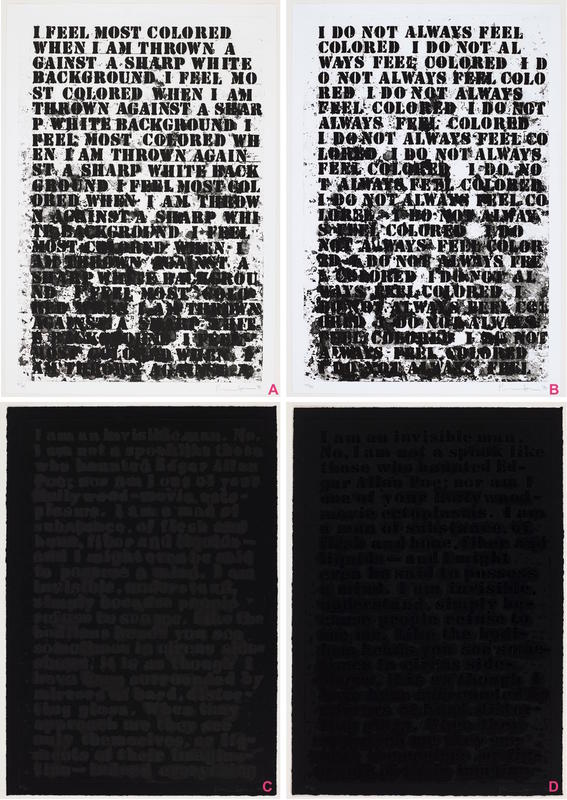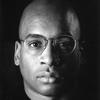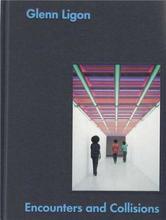More about Untitled: Four Etchings [A-D]
- All
- Info
- Shop

Contributor
Between 1991-1992, American conceptual artist Glenn Ligon (b. 1960) produced the series Untitled: Four Etchings [A-D].
The series uses quotes (or in artspeak appropriates text) from both Zora Neale Hurston’s essay “What it Means to Be Colored Me” and Ralph Ellison’s Invisible Man with etchings [A] and [B] quoting Hurston and [C] and [D], Ellison. On a process-based note for art nerds like me, Ligon’s soft-ground etchings use the alternative printmaking processes of ‘spitbite’ and ‘sugarlift.’ What this means is that the printing matrix (usually a zinc-plate, but a copper plate can be used) is prepared with an acid-resistant coating called soft-ground. The prepared plate is then drawn on with acid from the acid bath for the “spitbite,” while for “sugarlift” the plate is painted with a solution of gum arabic, hot water, and sugar. Ligon combined these processes to intentionally highlight and obscure Hurston and Ellison’s appropriated texts.
Controversially, Ligon and the curator Thelma Golden are credited with coining the term “post-blackness.” For Ligon, the term “post-blackness” describes “the liberating value in tossing off the immense burden [for African-American or Black people] of race-wide representation, [and the] idea that everything they do must speak to or for or about the entire race.” Bearing this in mind for Ligon: “The [sic] prints [Untitled [A-D]] play with the notion of becoming ‘colored’ and how the ‘becoming obscures meaning and also creates this beautiful, abstract thing.” That makes, Ligon’s Untitled: Four Etchings [A-D] a bit of a revolutionary assertion of identity when they were made in the 90s and are equally so in a 2018 Trump-ocracy.
But, what’s crazy about Ligon’s intertextual musings on blackness is that they were made during the same time period as the Rodney King Riots; from the 1991 officer-involved beating of Rodney King, through the officers’ acquittal on April 3, 1992 and the resulting social upheaval of the acquittal’s aftermath in South Central LA. The ‘amateur’ camcorder footage of Rodney King’s death, shot by George Holliday was shown alongside Ligon’s Black Book, an erotic series of appropriated images of Robert Mapplethorpe’s black male nudes, at the 1993 Whitney Biennial. Holliday’s footage, shot on March 3rd, 1991 and entitled Videotape of the Rodney King Beating, showed the brutal and tragic death of Mr. King over a traffic stop and high-speed chase. Laura Cottingham wrote in frieze in 1993: The videotape has [sic] dominated the national media, popular consciousness, and also the subsequent trials, some still pending, of the white policemen who administered repeated blows to Mr. King after pulling him over on the highway for a traffic violation.
While Ligon’s Untitled: Four Etchings [A-D] didn’t directly engage with the media spectacle of Rodney King, they gave voice to an ideation of blackness that was ahead of his time. When juxtaposed against the Riots’ context, Ligon’s intertextual etchings make the viewer uncomfortably aware of the nuanced dimensions and history of race in America. And it’s this discomfort that Ligon’s work around identity brings up that is critical to conversations about race in America that we should be having.
Sources
- Associated Press. “Obamas Diversify White House Collection.” October 7, 2009. CBS. https://www.cbsnews.com/news/obama-diversify-white-house-art-collection… 8/23/18. https://www.nybooks.com/articles/2012/05/24/big-changes-black-america/
- Cottingham, Laura.“the pleasure principle” frieze. 1993. https://static1.squarespace.com/static/580e28a315d5db3c89dfcce1/t/59370…
- Drohojowska-Philp, Hunter“Glenn Ligon gets Obama’s vote.” Los Angeles Times. December 11, 2009. Date accessed, 8/21.
- Ellison, Ralph. Invisible Man. 1952. Pp. 1
- “Glenn Ligon, Untitled: Four Etchings (1991-1993).” MoMA, date accessed 8/23. https://www.moma.org/collection/works/153232
- Hurston, Zora Neale.“How It Feels to Be Colored Me.” 1927. http://www.casa-arts.org/cms/lib/PA01925203/Centricity/Domain/50/Hursto…
- “My Favorite Artist.” T Magazine. date accessed: 8/21 https://www.nytimes.com/video/t-magazine/100000005951066/my-favorite-ar…
- Sheets, Hilarie M.“For Glenn Ligon, Home is Where History and Friends are Inspirations.” 26 January 2017. New York Times. date accessed: 8/22/18, https://www.nytimes.com/2017/01/26/arts/design/for-glenn-ligon-home-is-…
- Tate, Greg “Bring the Word.” The Village Voice. 17 September, 1996. https://static1.squarespace.com/static/580e28a315d5db3c89dfcce1/t/59370…
- Untitled: Four Etchings [A-D], 1991-1993, Minneapolis Institute of Art, date accessed: 8/21, 10:51 PM https://collections.artsmia.org/art/43461/untitled-four-etchings-b-glen…
- Welsh, Ben and Jerome Adamstein.“The Los Angeles Times Front Pages During the 1992 LA Riots.” 28 April, 2017. Date accessed 8/23. http://www.latimes.com/projects/la-me-riot-front-pages/












